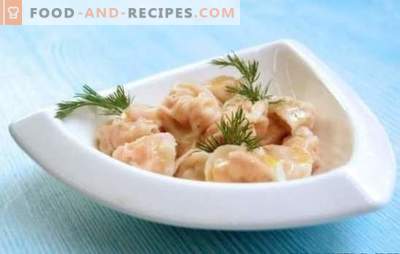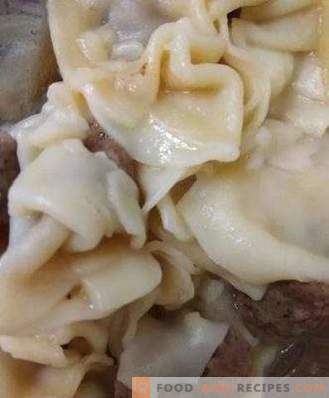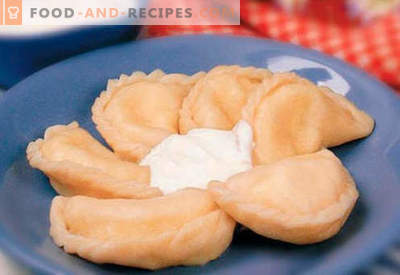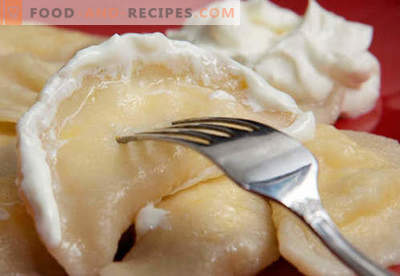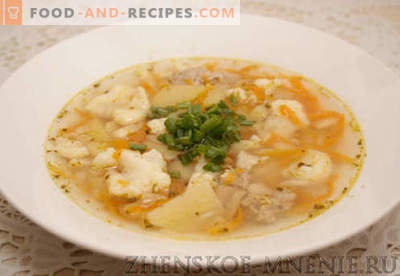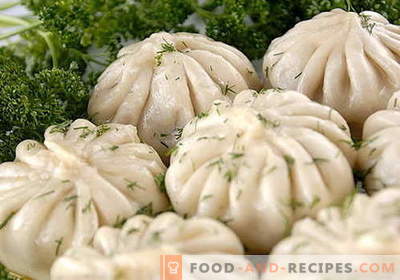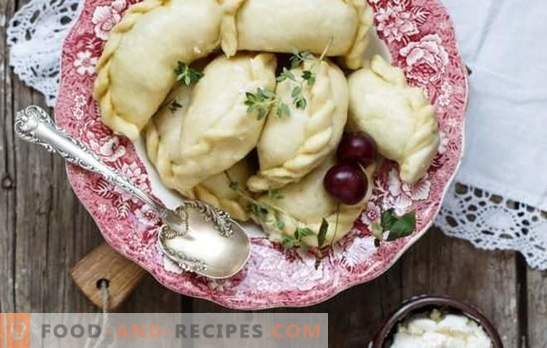
Not everything is meat, the dumpling. Dumpling can also be molded with meat filling and also cooked in water. But he will not become a ravioli. What is the difference between these dishes? You can dig a story. Dumplings - Russian dish, dumplings - traditional Ukrainian dish. But it is better to look at the difference from a different angle, there is something interesting.
Does form matter?
If you go to the store with semi-finished products, you can be surprised at the diversity of forms. More recently, the dumplings were exclusively in the form of crescents, and the dumplings had the shape of an ear.
Today you can meet triangles, squares, ears of different types, and even hexagons. But at home, more often adhere to the classical forms.
The exception is the use of a special dumpling lattice, it gives out rounded polygons.
Since the dumplings are boiled in water longer because of the raw meat filling, they are trying to give a compact shape that is close to a circle. If they are made in the form of crescents, then only shortened.
Dough for ravioli and dumplings
Dumplings and dumplings are mostly made from unleavened dough, but not always. In the classic version, it is based on water, flour, salt.
For plasticity, add an egg and some vegetable oil (not always).
Sometimes used custard types of unleavened dough, which differ in strength and delicate taste. But for dumplings you can mix other options.
What kind of dough can be kneaded:
- on kefir, yogurt;
- in milk;
- with soda, rippers;
- in broth.
The dough for the dumplings is softer, they cook faster, often one or two minutes after boiling water.
For dumplings you need a steep and strong mass, since the boiling time is on average ten minutes.
The filling should have time to prepare, and the shell does not fall apart.
Now it is very often cooked fresh dough with the addition of beets, spinach, various spices and even activated carbon. This allows you to get bright and unusual products. Such ingredients can be laid in the dough and for dumplings, and for dumplings.
Boil, hover or fry?
Another difference between dumplings and dumplings - cooking methods. The classic version is cooking in salted water. It differs only in duration, but the essence does not change. The only point is, dumplings need more water. If the filling is made of berries or juicy fruits, then they are prepared for a few things, while closely watching the process.
What other cooking methods are:
- Frying. Dumplings can be sent to the pan, pour a little water and oil, stew, and then fry. Dumplings are fried only after pre-boiling and not all types.
- Baking. Dumplings can be cooked in the oven in pots, in the forms to make various casseroles with cheese, sauces and vegetables. Dumplings are not cooked in the oven.
- Quenching. Raw or semi-ready dumplings can be braised in red or white sauce. Dumplings are simply filled with sour cream, butter, and sugar.
- Steaming. Dumplings do not cook like that. And dumplings are very common. Typically, this method is used for products with berries or when using a tender dough.
In general, dumplings are often an ingredient in other dishes. They are added to soups, casseroles, served in pots and just with broth. Vareniki is an exceptionally independent dish that is rarely mixed with something.
Meat here, meat there or what is the difference
Dumplings can also be made with meat. But in the dumplings are always raw stuffing. Stuffing never roast, do not stew. The remaining ingredients are also added exclusively raw. The exception is mushrooms. Dumplings can be cooked with their addition. If mushrooms are collected in the forest, they must first be boiled for at least half an hour in water, then chopped and added to the meat stuffing. But champignons, which are considered safe mushrooms, are sometimes fried, then sent to the filling. This enhances their faint aroma.
How toppings are prepared for dumplings:
- Meat, if the dumplings are boiled with it, or twisted. If minced meat is used, it is fried or stewed in a pan with a lid until half cooked.
- The vegetables and mushrooms that are planned to be used are also passaged in oil.
- The ingredients of the filling are combined, seasoned with spices.
- For juiciness, sometimes fat is added. Its thermal treatment is not necessary, it is enough to grind (twist, cut), combine with the other ingredients.
Another difference to the filling for meat dumplings is friability. Only raw minced meat has a thick and sticky consistency. If the meat is ready, it does not hold the form. Therefore, mashed potatoes are often added to the mincemeat for dumplings. Also, seal the mass and add juiciness by adding sour cream or mayonnaise.
Brothers dumplings and dumplings
Products from unleavened dough with meat a considerable amount. Despite the similarity of the main ingredients, the dishes are very different in taste, juicy filling, I have other forms.
What else can you cook:
- Khinkali. Famous Georgian dough bags with juicy filling. They have a very juicy and fragrant minced meat, as well as a large size. 3-5 portions are enough per serving.
- Chebupels. A modern semi-finished product that resembles dumplings. Differs in a variety of toppings, often sausages, cheese, but also with meat options are also found. Chebupels are fried in a lot of oil.
- Raviolli. Italian analogues of dumplings and ravioli. At home, they somehow belong to pasta. They can be square or crescent-shaped. Inside they lay minced vegetables, meat, poultry and even fish.
- Wonton. Chinese dumplings, which are also made with meat and poultry, often add plant stems. In shape, they look like khinkali. Unlike classic ravioli, they are served with noodles.
- Manty. A well-known analogue of ravioli, but it is cooked with a large amount of onions, sometimes from vegetables, differs in shape and steaming.
You can also recall the famous pasties, dumplings with stuffing, dumplings. b There are really a lot of analogs for dumplings and dumplings. All of them are somewhat different from each other, have their own history and features of preparation.

